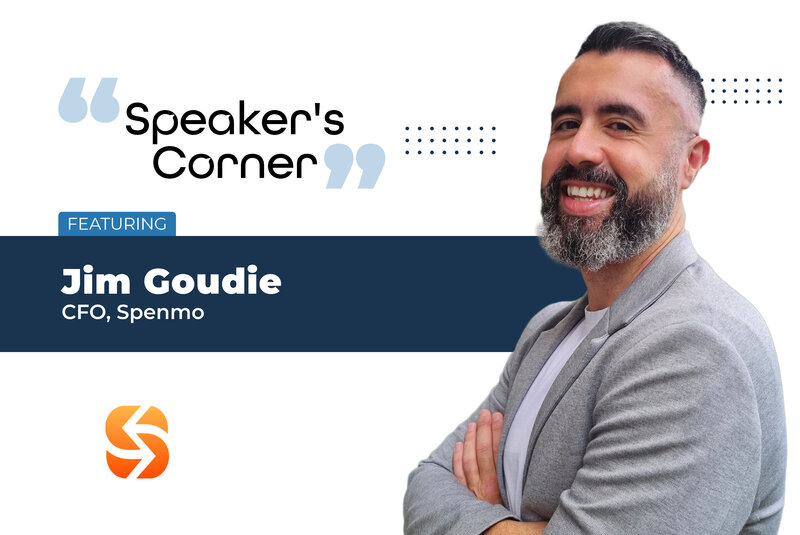
Jim Goudie, the CFO of Spenmo, is a finance professional with more than 15 years of experience. He has worked in various companies, ranging from publicly listed ones to fast-growing startups, in roles such as Financial Controller, FP&A, Head of Global Finance, and CFO. Jim has international experience, having studied and worked in South East Asia, the US, Europe, and West Africa.
In an interview with Eventible, he speaks in great depth about his background, his role as CFO at Spenmo, his strategies in dealing with challenges, his experience at Accounting & Finance Show Asia 2023, and much more!
● Please share a bit about your background and what led you to the role of CFO at Spenmo.
I’ve worked in a variety of roles that have led to eventually being a CFO, starting off as a trainee accountant in the Corporate Finance department and then working as a financial analyst in a number of industries. I soon realized that while Corporate Finance and FP&A were my main areas of interest, I knew I had to make a move into Controllership to understand how to complete audits, become more familiar with technical accounting, and work in other areas such as understanding Balance Sheets, AR and AP plus tax. I was an FC in SE Asia for a US listed Oil and Gas company for nearly five years and then made the leap into start-ups, helping Xendit become the first Indonesian PG to get to Unicorn status and expand into a number of other countries before moving to Spenmo at the end of July 2023
● As the CFO of Spenmo, what are your primary responsibilities, and how do you contribute to the overall financial strategy and success of the company?
My primary responsibility at Spenmo is extremely varied; in terms of the accounting side, my main responsibility is ensuring we work towards being able to have our financials audited while also ensuring the correct checks and balances are in place; this is very important when dealing with customer funds which Spenmo does as well as the usual monthly filing for tax and regulators.
In terms of looking forward, I also need to ensure the company is set up for success, initially by contributing to the product we want to roll out and then ensuring that the unit economics make sense. This is where I work with the FP&A team to confirm the pricing we are aiming for, the cost we want to incur from our partners, be it our payment gateway partners or data partners, and then forecast how things will play out in terms of margin and growth.
Add to this that we have entities across a few countries; I need to put my treasury hat on and plan our cashflow for the next few months so that cash is in the right place at the right time, as well as work with our banking partners to maximize the interest our cash is generating. Finally, I do a lot of external business partnering, especially with our investors and board members, like providing monthly business reviews, updates of actuals versus forecasts, and providing insights into our company performance. So, all in all, being a CFO at Spenmo really is a varied role.
● Spenmo focuses on expense management. How does the finance team contribute to developing and implementing strategies to optimize client expense processes?
Spenmo serves as a powerful platform empowering finance teams by simplifying expense workflows, enhancing spend visibility, and enabling better control. Beyond just being a support for business operations, the finance team at Spenmo actively engages in product development. They play a pivotal role by testing functionalities and offering invaluable feedback to the product and design teams. Their involvement is crucial as they represent the ideal end users, ensuring that our aim to simplify their lives translates directly into user-centric features and designs.
● Finance in a technology-driven company often involves unique challenges. How do you navigate financial management in a tech-oriented environment, and what specific considerations does Spenmo address in this context?
In a tech-oriented environment, embracing a culture of agility and rapid innovation is crucial. At Spenmo, we deeply empathize with the challenges faced by finance teams in this fast-paced landscape. The modern expectations demand not just efficiency but also the ability to focus on high-value tasks and analysis.
Our product is designed with this understanding at its core. We aim to revolutionize the Accounts Payable process, empowering finance teams to surpass these expectations. By streamlining and optimizing AP processes by moving away from manual processes. We provide them with the tools to adapt swiftly and allocate more time to tasks that truly add value, enabling them to thrive in this evolving landscape.
● Cash flow management is crucial for any business. How do you approach cash flow forecasting and optimization to ensure financial stability for Spenmo?
Having full visibility of a company’s cash and cash flow trends is extremely important for planning purposes. When I first joined Spenmo, one of the first things I did was create a cashflow Excel file with every single bank account and note down the balance at the end of the month for the previous three months. Since Spenmo manages customer funds, I worked to ensure total segregation between bank account usage since you’re not allowed to co-mingle funds. Then, from there, I was able to build a picture of which country and entity and for what purpose the cash that was sitting in our bank was in total.
From there, it became easier to manage, and I worked with my accounting team to see where our main expenses were being incurred and moved enough funds to ensure we could meet our obligations, with excess cash being kept in high-interest bank accounts like Time Deposits or Money Market Funds, so its actually not that difficult.
Having said that, if you don’t have a good accounting team in place to track expenses properly, then this can be a struggle. Going forward, we plan to automate our treasury management with an automated solution to reduce the manual work it takes to update our bank balances.
● Collaboration across departments is essential for effective financial management. How do you foster communication and collaboration between the finance team and other departments within Spenmo?
I am a firm believer in communication across the company and working in a flatter structure where executives can easily be reached by the rest of the teams, be it finance or non-finance. How I’ve worked to ensure finance is visible at Spenmo is we set up a company-wide bi-weekly meeting where each team explains their goals and aims for the next two weeks so that other teams can see how they can help or if it affects their area.
Additionally, I make sure I attend meetings related to issues such as sales, product, and tech so that I can provide input where necessary; this is very important for things like pricing or working with payment gateway partners. In my opinion, this is crucial to succeed in being a business partner since teams outside of Finance may not know that what they are doing has an impact on finance, such as fund flows or the profitability of the company.
● In your experience, what are the key financial metrics or KPIs that are particularly important for a company like Spenmo, and how do you track and analyze them?
Spenmo works across the Payments, Cards, and SaaS space, so there are a number of metrics we use to ensure we are on the right path. For Payments and Cards, the main metrics we use are gross take rates and net take rates, which are basically how well we are converting our Total Processed Volume of funds into Gross Revenue and Gross Profit; naturally, the higher the number, the better, but myself coming from a Payment Gateway background there is a certain number we want to meet in order to achieve positive gross margins so we have a target in mind.
Then, of course, there are the standard metrics, such as Revenue per Customer or Transaction and Gross Profit per Customer. For SaaS, we need to cover the cost of our data partner, so our monthly customer base and our achieved pricing are key; again, we have our targets to achieve since we know what pricing we need to hit in order to be profitable. How we track right now is with our data analytics tool that are data team looks after, and there is close collaboration between finance and data to ensure the right numbers are being reported, and of course, we compare to our plan for 2024.
● How do you assess and manage financial risks for Spenmo, and what strategies do you employ to mitigate potential challenges?
For 2024, we laid out a base case of numbers we wanted to achieve, but naturally, the best-laid plans do not always pan out, so we do numerous stress tests and scenario planning. So, for example, if our sales target isn’t hit, then how will this look, and we ensure our board realizes the risk involved in our yearly plan. In addition, our FP&A team will model out a variety of different pricing points or vendor costs to see where we may fall short of our gross profit target and what action we can take to achieve the target, such as reducing cashback or discounts we give to customers. Proper planning is crucial so that we know where the risks are and can take action in order to achieve our yearly plan.
● As a CFO, what leadership principles do you prioritize, and how do you foster a culture of financial responsibility and accountability within the organization?
I’m a big fan of being open and transparent, and recently have been working on being more of a servant leader. In my opinion, being transparent is a great way to keep the team engaged and see why they are doing their role and for what purpose, while being a servant leader has meant getting buy-in from the team, as people tend to prefer being asked what to do and know why they are doing it as opposed to being told what to do and they don’t know why. Given that Spenmo is less than 100 people, I also like to get my hands dirty and I think this shows the team that we are all in it together, and I’m happy to roll up my sleeves and achieve our goals. I believe this works as in my previous company, the attrition rate of the finance team was less than 1% with a team that was spread across five different countries so I think universally this type of leadership style works.
● How was your experience attending Accounting & Finance Show Asia 2023, and what was your biggest takeaway?
The energy at the Accounting and Finance show was really incredible. It’s always eye-opening to hear firsthand about the challenges finance teams encounter. The need to streamline expenses without compromising control and visibility is a common pain point. Preventing unauthorized spending is indeed a complex issue that demands attention.
It’s fascinating how areas like vendor and subscription management can significantly impact a company’s finances. Many organizations might not realize the extent of their spending on subscriptions. Providing solutions that offer better control and visibility over these expenditures could be a game-changer for them. We do have a wealth of ideas that could truly revolutionize expense management and empower finance teams to navigate these challenges more effectively!
● Looking ahead, what financial trends or changes do you foresee in the fintech industry, and how is Spenmo positioning itself to adapt to these developments?
I think Spenmo is incredibly lucky to be in the position it is, where it has Fintech products such as Corporate Cards and Bill Payments, as well as its SaaS product, which is AP Management and Expenses.
The next area I believe to be the next trend is helping Finance teams achieve automation, be it with the automation of manual tasks or the automation of data analysis. Currently, there is the notion of Finance 4.0, where AI and RPA will make finance teams more efficient, but right now, I feel as though it’s in its infancy, and there is a lot of potential to really grow this space.
Spenmo itself, the sales team speaks a lot with finance professionals to see where their pain points are and is working to solve this for them. Some of our MVPs next year, which I’m very excited about, will look to address these issues, and I can’t wait to use them myself!




Comments are closed.